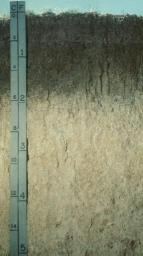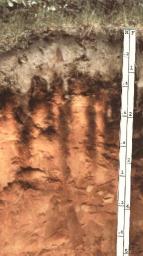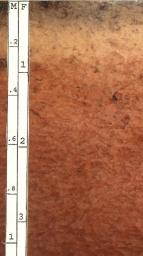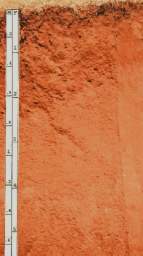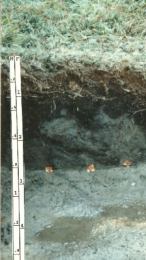|
Soil Systems
Mollisols are among the most fertile soils on
the Earth. Born under grassland vegetation, these soils are well-known for their dark
brown to black organic rich surface layers. These
soils have a granular structure and soft consistency when dry. Mollisols are
rich in calcium and others nutrients, and generally posses high moisture
retention. Calcium nodules are
found near the base of the soil as calcium carbonate precipitates out of soil water.
Mollisols are found in the drier portions of the humid continental climate through the
steppe climate.
Figure 11.27 Mollisol
Click image to enlarge (Image Source:
USDA NRCS Used with permission)
Spodosol soil is commonly found in cool, moist
environments under coniferous forest vegetation. Surface litter composed of pine needles
breaks down in the presence of water to form a weak organic acid. Acidic soil water
removes base ions in solution to create an acidic soil. Easily dissolved materials are
leached from surface layers leaving behind the most resistant material like quartz,
creating an ashy-gray near-surface layer. Layers at depth are stained with iron and
aluminum oxides.
Figure 11.28 Spodosol
Click image to enlarge (Image Source:
USDA NRCS Used with permission)
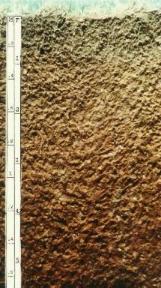 Alfisols are soils
developed under temperate forests of the humid midlatitudes. Eluviation is moderate and base
status is fairly high in these soils. Common to the humid continental (like the one in
Michigan on the left) and humid subtropical
climates, these soils are well-developed and contain a subsurface layer of clay called an
argillic horizon. Some alfisols are found in the wet/dry tropical climate of Africa, South
America, Australia, and Southeast Asia. Having a favorable moisture balance and good
fertility, they are very productive soils for agriculture. In fact, they have been
successfully used for farming in China and Europe for thousands of years. Alfisols are
abundant on older glacial deposits in the United States, and loess deposits in and near
the Mississippi embayment. Alfisols are soils
developed under temperate forests of the humid midlatitudes. Eluviation is moderate and base
status is fairly high in these soils. Common to the humid continental (like the one in
Michigan on the left) and humid subtropical
climates, these soils are well-developed and contain a subsurface layer of clay called an
argillic horizon. Some alfisols are found in the wet/dry tropical climate of Africa, South
America, Australia, and Southeast Asia. Having a favorable moisture balance and good
fertility, they are very productive soils for agriculture. In fact, they have been
successfully used for farming in China and Europe for thousands of years. Alfisols are
abundant on older glacial deposits in the United States, and loess deposits in and near
the Mississippi embayment.
Figure 11.29 Alfisol
Click image to enlarge (Image Source:
USDA NRCS Used with permission)
Ultisols share many of the same properties as Oxisols. Highly weathered soils, they are often red/yellow
in color reflecting the oxidation of iron and aluminum. Found in the moister portions of
the Humid Subtropical climate, they
have a illuvial clay layer which distinguishes them from Oxisols
which do not.
Figure 11.30 Ultisol
Click image to enlarge (Image Source:
USDA NRCS Used with permission)
Oxisol soil is found in warm, rainy climates
under broadleaf, evergreen vegetation like that found in the rain forest. Chemical
weathering (especially oxidation) in the presence of warm temperatures combined with
heavy rainfall creates a soil rich in iron and aluminum oxides called
"sesquioxides". A rich diversity of decomposers, rapid uptake by
vegetation, and heavy precipitation quickly removes nutrients from the soil. What is
left is a nutrient poor soil, not well-suited for agriculture. Cleared of vegetation, the
exposed surface is easily eroded.
Figure 11.30 Oxisol
Click image to enlarge (Image Source:
USDA NRCS Used with permission) |
